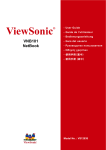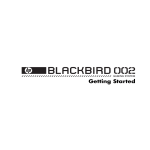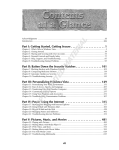Download GBC F - 160 CE Laminate Trimmer User Manual
Transcript
Mini Trackball Optical Mouse Visit our Web site at: www.targus.com Features and specifications are subject to change without notice. © 2003 Targus Corp. USER’S GUIDE 400-0122-001B BRUSSELS HANNOVER BARCELONA TOKYO MILANO AMSTERDAM SINGAPORE LONDON PARIS NEW YORK LOS ANGELES TORONTO HONG KONG SYDNEY MINI TRACKBALL OPTICAL MOUSE Introduction Congratulations on your purchase of the Targus Mini Trackball Optical Mouse. This ergonomically designed mouse connects directly to your computer’s USB port and allows you to: • Alternate between the trackball and mouse modes, which ever best suits your needs • Enhance your Internet browsing capabilities • Quickly access program feature options supported under the Windows® operating system This user’s guide describes how to connect the mouse to your computer, install the device drivers and personalize the mouse features. In addition to this guide, this package contains: • Targus Mini Trackball Optical Mouse • Driver software CD-ROM System Requirements To use the mouse, your computer must meet the following hardware requirements and run one of the operating systems listed. 2 Mini Trackball Optical Mouse Hardware • 64 MB RAM or higher, depending on the operating system • CD-ROM drive • USB version 1.1 port Operating System • Windows® Me/2000/XP Connecting the Mouse To connect the mouse to an available USB port, plug the standard USB end of the cable into an available USB port on your computer. You are now ready to install the device drivers for your operating system. Installing the Device Drivers To install the supplied device driver: 1 Turn on your computer. 2 Insert the driver software CD into your computer’s CD-ROM drive. 3 Click Start, Run, then enter D:\Setup.exe (where D: is the path of your CD-ROM drive) and then click OK. The Welcome screen appears. 4 Follow the on-screen instructions. 5 Click Finish to complete the driver installation and restart your computer. Once your computer restarts, the mouse icon appears in the system tray. 3 Mini Trackball Optical Mouse Activating the Trackball Feature The mouse’s default setting is mouse mode, where the trackball functions as a standard scroll wheel. To enable the trackball mode: 1 Press and hold down the middle mouse button (the trackball) and the right mouse button at the same time. 2 Release both buttons. You are now able to control your cursor by moving the trackball while the mouse is stationary or held in your hand. To disable the trackball mode: 1 Press and hold down the middle mouse button (the trackball) and the left mouse button at the same time. 2 Release both buttons. NOTE: Turning off your computer or disconnecting and reconnecting the mouse automatically disables the trackball mode. Personalizing the Mouse Features NOTE: You may have to remove previously installed mouse or touchpad software from your computer to fully customize the mouse features. You can assign functions to the scroll ball and third mouse button and control cursor movement by personalizing the mouse features from the Mouse Properties screen. To do this: 1 Click Start, Settings and Control Panel. 2 Double-click the Mouse icon. The Mouse Properties screen appears. 4 Mini Trackball Optical Mouse Depending on your operating system, this screen has either five, six or seven tabs with options for selecting and controlling mouse features. To save any changes, click Apply. NOTE: The following option tabs are for all supported operating systems, except where indicated. Buttons Tab Button configuration — allows you to assign the primary mouse button for right- or left-handed use. Files and Folders (Windows® 2000 only) — allows you to assign the number of clicks that are required to open an item. Double-click speed — adjusts how fast you have to click the mouse button to register a double-click. ClickLock (Windows® XP only) — allows you to drag an icon without holding down the mouse button. Pointers Tab This tab allows you to choose how the mouse pointer looks on the screen. Pointer Options Tab (Windows® Me/XP) Motion — adjusts the speed at which the pointer moves across the screen. Snap to — allows you to assign the pointer to jump to default buttons in dialog boxes. Visibility — allows you to display pointer trails, hide the pointer while typing and show pointer location when Ctrl is pressed. 5 Mini Trackball Optical Mouse Wheel Tab (Windows® XP only) This tab allows you to adjust the scrolling speed. Select the number of lines that are scrolled at one time or select to scroll one screen at a time. Motion Tab (Windows® 2000 only) Speed — adjusts the speed at which the pointer moves across the screen. Acceleration — adjusts the acceleration rate for the pointer. Snap to default — allows you to assign the pointer to jump to default buttons in dialog boxes. Hardware Tab (Windows® 2000/XP) Selecting the Hardware tab displays general information about the mouse. Scroll Ball Tab Wheel Mode — allows you to choose between the following modes: • System default (Intelli-Mouse) mode – enabling this mode simulates Microsoft® IntelliMouse® and supports features used with Microsoft® applications, such as zoom, scrolling and Auto-scrolling. • Enhanced Scroll Mode – this mode supports all applications that use scroll bars, with zoom, Auto-panning and scrolling functions. Vertical Axis Setting — allows you to adjust the following features for up and down scroll ball movement. • Reverse – allows you to turn the reverse mode on and off. 6 Mini Trackball Optical Mouse • Scroll – adjusts the scrolling speed, per line of text. The settings range is 1 (slow) to 10 (fast). • Scroll one page per scroll unit – adjusts the scrolling speed, per one page of text. Horizontal Axis Setting — allows you to adjust the following features for left and right scroll ball movement. • Use for horizontal axis – enabling this feature allows for side scroll ball movement. • Reverse – allows you to turn the reverse mode on and off. • Scroll – adjusts the scrolling speed, per line of text. The settings range is 1 (slow) to 10 (fast). • Scroll one page per scroll unit – adjusts the scrolling speed, per one page of text. • Use for application switch – enabling this option allows you to use the scroll ball as a toggle button to alternate between two or more active applications or tasks. Emulates the Alt + Tab keyboard shortcut. • Use for Web site switch – enabling this option allows you to use the scroll ball as a toggle button to alternate between two active Internet sessions. Third Button Tab This tab allows you to assign a frequently used mouse or keyboard function to the third mouse button. The options are: Launch Default Browser — opens an active Internet session via your default browser. Launch Default E-Mail — opens your default email application. 7 Mini Trackball Optical Mouse Office 97 Document Zoom (Ctrl Lock) — allows you to magnify or minimize documents in Microsoft® Office 97 and enables quicker access to some keyboard shortcuts. Shift Lock — locks the Shift key for alternate key strokes. Emulates holding down the Shift key on the keyboard. Zoom — allows you to increase (zoom in) or decrease (zoom out) the magnification of a graphic. • Zoomed Area – allows you to define the size of the section for magnification. The settings range is 2 x 2 (smallest) to 64 x 48 (largest). • Zoom Factor allows you to define the magnification level. The settings range is 2 (lowest) to 8 (highest). Auto Scroll — allows you to scroll a document, graphic or Web site without the “trackball.” To disable this feature, click the left mouse button one time. Others — allows you to assign one of 38 available keyboard functions, such as Enter, Page Up, Page Down, F1 - F10 and Tab. Things to Remember Safety Measures Never point the mouse’s optical sensor toward the face, particularly the eyes, to avoid possible injury. Operating Hints When using an optical mouse, for optimal performance: • Never use the mouse on a glass or mirrored surface or on black velvet as these surfaces will cause the mouse to fail temporarily. 8 Mini Trackball Optical Mouse • Avoid using the mouse on surfaces with repetitive patterns, such as printed magazine photographs, as this type of surface may cause the mouse to respond slowly or fail temporarily. Comfortable Usage Research suggests that physical discomfort and injury to nerves, tendons, and muscles may be related to repetitive motion, an improperly set up work area, incorrect body posture, or poor work habits. To reduce the risk of injury, follow these precautions: • Stand, stretch, and move around several times every hour. • Switch hands while performing tasks. Use shortcut keys to avoid repetitive or awkward mouse movements. • Relax your shoulders and keep your elbows at your sides. Adjust the keyboard’s position so that you don’t have to stretch to reach it. • Adjust your position so that you don’t have to bend your wrists to type; avoid placing your wrists on a sharp edge. If you feel discomfort or numbness in your hands, wrists, arms, shoulders, neck, or back while typing, consult a qualified medical professional. Technical Support For technical questions, please visit: Internet: http://www.targus.com/support.asp Australia Internet: www.targus.com.au Email: [email protected] Monday through Friday, 8:30 a.m. (08:30) to 5:30 p.m. (17:30) Eastern time: 1-800-641-645 9 Mini Trackball Optical Mouse Canada Monday through Friday, 9:00 a.m. (09:00) to 5:00 p.m. (17:00) Eastern time: 888-827-4877 Europe Belgium Denmark France Germany Italy Netherlands Spain Sweden Switzerland United Kingdom Eastern Europe & others +32 0 02-717-2451 +45 0 35-25-8751 +33 0 1-64-53-9151 +49 0 21-16-579-1151 +39 0 24-827-1151 +31 0 53-484-9470 +34 0 91-745-6221 +46 0 8-751-4058 +41 0 1-212-0007 +44 0 20-7744-0330 +31 0 53-484-9479 Product Registration For more efficient customer service and to activate the product’s warranty, Targus recommends that you register your Targus accessory shortly after purchasing it. To register your Targus accessory, go to: http://www.targus.com/registration.asp You will need to provide your full name, email address, phone number, and company information (if applicable). Warranty Targus warrants this product to be free from defects in materials and workmanship for one year. If your Targus accessory is found to be defective within that time, we will promptly repair or replace it. This warranty does not cover accidental damage, wear and tear, or consequential or incidental loss. Under no conditions is Targus liable for loss of, or damage to a computer; nor loss of, or damage to, programs, records, or data; nor any consequential or incidental damages, even if 10 Mini Trackball Optical Mouse Targus has been informed of their possibility. This warranty does not affect your statutory rights. Warranty Registration at: http://www.targus.com/registration.asp Regulatory Compliance This device complies with Part 15 of the FCC Rules. Operation is subject to the following two conditions: (1) This device may not cause harmful interference, and (2) This device must accept any interference received, including interference that may cause undesired operation. FCC Statement Tested to Comply This equipment has been tested and found to comply with the limits of a Class B digital device, pursuant to Part 15 of the FCC Rules. These limits are designed to provide reasonable protection against harmful interference in a residential installation. This equipment generates, uses, and can radiate radio frequency energy and if not installed and used in accordance with the instructions, may cause harmful interference to radio communications. However, there is no guarantee that interference will not occur in a particular installation. If this equipment does cause harmful interference to radio or television reception, which can be determined by turning the equipment off and on, the user is encouraged to try to correct the interference by one or more of the following measures: • Reorient or relocate the receiving antenna • Increase the separation between the equipment and receiver • Move the computer away from the receiver • Connect the equipment into an outlet on a circuit different from that to which the receiver is connected. Microsoft, IntelliMouse and Windows are registered trademarks of Microsoft Corporation. All other trademarks are the property of their respective owners. 11





















